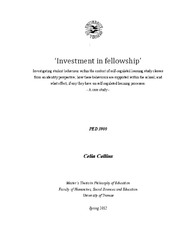A self-guided anomaly detection-inspired few-shot segmentation network
Permanent lenke
https://hdl.handle.net/10037/28499Dato
2022-11-13Type
Journal articleTidsskriftartikkel
Peer reviewed
Forfatter
Salahuddin, Suaiba Amina; Hansen, Stine; Gautam, Srishti; Kampffmeyer, Michael; Jenssen, RobertSammendrag
Standard strategies for fully supervised semantic segmentation of medical images require large pixel-level
annotated datasets. This makes such methods challenging due to the manual labor required and limits the
usability when segmentation is needed for new classes for which data is scarce. Few-shot segmentation
(FSS) is a recent and promising direction within the deep learning literature designed to alleviate these
challenges. In FSS, the aim is to create segmentation networks with the ability to generalize based on
just a few annotated examples, inspired by human learning. A dominant direction in FSS is based on
matching representations of the image to be segmented with prototypes acquired from a few annotated
examples. A recent method called the ADNet, inspired by anomaly detection only computes one single
prototype. This prototype captures the properties of the foreground segment. In this paper, the aim is
to investigate whether the ADNet may benefit from more than one prototype to capture foreground
properties. We take inspiration from the very recent idea of self-guidance, where an initial prediction
of the support image is used to compute two new prototypes, representing the covered region and the
missed region. We couple these more fine-grained prototypes with the ADNet framework to form what
we refer to as the self-guided ADNet, or SG-ADNet for short. We evaluate the proposed SG-ADNet on a
benchmark cardiac MRI data set, achieving competitive overall performance compared to the baseline
ADNet, helping reduce over-segmentation errors for some classes.
Beskrivelse
Forlag
CEUR Workshop ProceedingsSitering
Salahuddin, Hansen, Gautam, Kampffmeyer, Jenssen. A self-guided anomaly detection-inspired few-shot segmentation network. CEUR Workshop Proceedings. 2022;3271Metadata
Vis full innførselSamlinger
Copyright 2022 The Author(s)
Med mindre det står noe annet, er denne innførselens lisens beskrevet som Attribution 4.0 International (CC BY 4.0)
Relaterte innførsler
Viser innførsler relatert til tittel, forfatter og emneord.
-
Experiential Learning and Digital Learning - Contradictory or Complementary? The Idea of 'Learning by Doing' and its Relevance for Today's Teaching and Learning
Zoglowek, Herbert Gottfried; Aleksandrovich, Maria (Chapter; Bokkapittel, 2018)In the beginning of the 20th century, ‘learning by doing’ and ‘experiential learning’ were new progressive ideas in education. They are not only still actual, but also booming since the end of the last century. Nowadays, however, since the beginning of the 21th century digital or e-learning seems to be a new magic word in education. Is it a beginning of a new era, where new possibilities create new ... -
Developing capabilities in market learning, network learning and internal learning. A case study of a Born Global entering the commercialization stage
Johansen, Morten (Master thesis; Mastergradsoppgave, 2018-11-30)The purpose of this thesis is to describe and explain how a Norwegian-based Born Global develop their capabilities in market learning, network learning and internal learning around the time of their first commercial product launch. -
Investment in fellowship : investigating student behaviour within the context of self-regulated learning study classes from an identity perspective; how these behaviours are supported within the school; and what effect, if any they have on self-regulated learning processes : a case study
Collins, Celia (Master thesis; Mastergradsoppgave, 2012-06)By incorporating self-regulated learning study (SRL) classes into its timetable, Breivang Senior High School has created a specific arena for the school to potentially realise its obligations and responsibilities to key aims in the Upper Secondary Education Act. However, the teaching staff is frustrated that the students do not take responsibility for their learning in the study classes. This case ...


 English
English norsk
norsk



